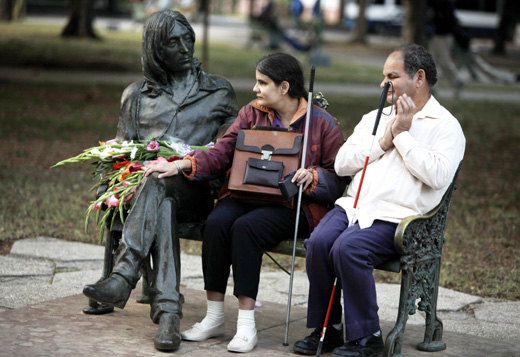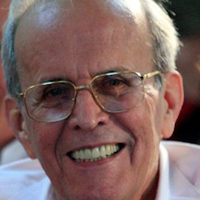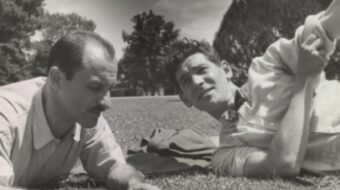
As people in the United States and around the world commemorate the memory of John Lennon on the anniversary of his 1981 murder, Dec. 8, Cuba honors the musician as a messenger of peace.
HAVANA (Granma) – From the roof of the Central Museum of Decorative Arts, Beatles fan musicians flooded the dawn of this city with songs of the legendary band on the 30th anniversary of the assassination of John Lennon, reports AIN.
Mostly fans, the eight performers at the concert raided the English group’s memorable discography with Let It Be and Don’t let me down, to close with Imagine, the theme created by Lennon that has transcended to become a call for world peace.
The idea of playing from a high point of the city was inspired by the last live performance of the Beatles, January 30, 1969 from the roof of the Apple label, in London, said Wilfredo Rodriguez, one of those involved in the tribute.
Guillermo Párez, a specialist of the Provincial Heritage Centre, told AIN that the first Saturday of each month, at that institution, there is a meeting or Peña dedicated to one of the most successful and acclaimed rock bands in the history of popular music.
The gathering is attended by a public loyal to the musical legacy of John Lennon, Paul McCartney, George Harrison and Ringo Starr, in an area where the anthologies and less known works of the group predominate, he said.
Every December 8th the group from the Peña de los Beatles pays special tribute to Lennon, who was killed at the hands of a fanatic in 1980 at the entrance to the Dakota building in New York.
On December 8, 2000 a statue of John Lennon by Cuban sculptor José Villa was dedicated in a park in the Vedado neighborhood of Havana. The statute was unveiled by President Fidel Castro Ruz and singer Silvio Rodriguez. We reprint here the speech given by Ricardo Alarcon Quesada, President of the Cuban National Assembly.
Dear John, you were always among us
Ricardo Alarcon Quesada
Compañeras y compañeros:
Here, in front of the excellent work of art of José Villa, we return to listen to what some said twenty years ago today: “About this man you can believe anything except that he is dead.”
Nostalgia does not bring us together. We are not inaugurating a monument to the past, nor a site to commemorate something that disappeared.
This place will always be a testimonial to struggle, a summoning to humanism. It will also be a permanent homage to a generation that wanted to transform the world, and to the rebellious, innovative spirit of the artist who helped forge that generation and at the same time is one of its most authentic symbols.
The sixties were much more than a period in a century that is ending. Before anything else, they were a attitude toward life, that profoundly affected the culture, the society and politics, and crossed all borders. Their renewing impulse rose up, victorious, overwhelming the decade, but it had been born before that time and has not stopped even up to today.
To these years we turn our sights with the tenderness of first love, with the loyalty that guards all combatants for their earliest and most distant battle. Some still denigrate them, with obstinate antagonism, those who know that to kill history they must first tear out its most luminous and hopeful moment.
This is how it is, and has always been in favor of or against “the sixties.”
In that time old imperial colonies fell, people previously ignored arose and their art, their literature, their ideas started to penetrate the opulent nations. The Third World was born and tricontinental solidarity, and some discovered that there, in the rich north, existed another Third World that also awakened.
In the United States, a century after the Civil War, black people fought for the right to be treated as persons and with them marched many white students. In Europe the young people repudiated imperial violence and identified themselves with the condemned of the earth. Nobody spoke yet of globalization but, for everyone, the Earth got smaller, the whole world became closer.
Then, finally liberated, appeared Cuba, truly discovered in 1959 as an inseparable part, fully pledged to liberty, life and truth.
Victory seemed immediate. To obtain it, people strived without rest. In mountains and cities, with stones and fists, with weapons snatched from the oppressors and also with speeches, poems and songs. They tried to assault the sky, to conquer, in a single act, all justice, for the black and the woman, for the worker and the poor, for the sick, the ignorant, and the marginalized. They believed they could arrive at a horizon of peace between nations and equality among men.
It was more than anything the rebellion of the youth. Before their impetus fell dogmas and fetishes, they broke the molds of Pharisee and banality, they turned back the dull mediocrity of an unjust and false society that reduces man to merchandise and converts everything into false gold.
Years afterward, and affirming the continuity of the movement, Lennon described it with these words: “The Sixties saw a revolution among the youth … a complete revolution in the mode of thinking. The young people took it up first, and the following generation afterwards. The Beatles were a part of the revolution. We were all in that boat in the sixties. Our generation – a boat that went to discover the New World. And the Beatles were the lookouts on that boat. We were a part of it.”
Tumultuous was the passage from that memorable concert in 1963 when Lennon asked the people who occupied the most expensive theater seats to, instead of applauding, just rattle their jewels, to six Novembers later when he returned the Order of the British Empire in protest of the aggression in Vietnam and the colonialist intervention in Africa. The refusal to perform before an exclusively white public in Florida, in 1966; the refusal to perform in the South Africa of apartheid; the denunciation of racism in the United States when he arrived there to participate in concerts that had been boycotted by the Ku Klux Klan; the calls for peace in the Middle East; the support for young people who deserted the Yankee aggressor army and the constant support to the Vietnamese resistance and the struggle of the Irish people; the incessant search for new forms of expression, without ever abandoning the roots and authentic language of the people; the repudiation of the bourgeois system, its codes and merchandizing mechanisms; the creation of a corporation to combat them and defend artistic liberty, an entity to which was attributed, even, a certain communist inspiration.
The personal contribution of John Lennon stood out singularly and endured beyond the dissolution of the group. His songs form a most complete inventory of the collective struggle of the young people for peace, revolution, popular power, the emancipation of the working class and of women, the rights of indigenous peoples and racial equality as well as the liberation of Angela Davis and John Sinclair and other political prisoners, the denunciation of the massacre at Attica and the situation in North American prisons, in an interminable list. Beyond the music, in interviews and public statements, he openly expressed his identification with the socialist ideal.
Lennon was the object of intense and obstinate persecution by the Yankee [U.S. government] authorities. The FBI, the CIA and the Immigration Service, instigated directly by Richard Nixon, the trickiest tenant the White House has ever had, spied on him and harassed him and strived to expel him from the United States. In spite of what their laws say and the countless measures carried out during a quarter of a century, these agencies still maintain in secret the documents proving the tenacious harassment they unleashed against him. The little that they have revealed shows that in just one year, between 1971 and 1972, the secret informants of their spies accumulated 300 pages and a file that weighs 26 pounds.
With no other weapons than his talent and the solidarity of lots of North Americans, he was forced to confront for several years the powerful Empire led by the most sordid and arrogant political machine. This chapter will remain in history as an example of moral force and the force of ideas, and from it Lennon emerged as a paradigm of the entirely free and creative intellectual, precisely engaged with his time.
Dear John, It was more than a few who said, twenty years ago, that the 8th of December was the end of an era. Many feared it among the millions who offered you ten minutes of silence and the multitude that on the 14th congregated in Central Park in New York to express a pain that time does not placate.
It was Yoko who then advised: “the message should not end.” And little Sean, knew how to express the greater truth: He imagined you bigger, after death, “because now you are everywhere.”
You were always among us. Now, in addition, we offer you this bench where you can rest and this park to receive your compañeros and friends.
Your message could not disappear because love had, and still has, many battles to fight. Because you had the privilege to hear it in millions of voices that became yours and continued raising it up like a hymn.
Wasn’t it a yellow submarine that surfaced that afternoon in 1966 in the port of New York and marched at the front of thousands of young people who condemned the war? How many hundreds of thousands demanded that peace be given a chance, and were in solidarity with the people of Vietnam, there in Washington, in front of the monument, that unforgettable November 15th in 1969? On that day, didn’t your art reach its highest realization? How many times did it not multiply from Berkeley to New England and from one continent to another, that generation that believed that love could prevail over war? John, I am sure that you remember the martyrs of Kent State University who wanted to follow you, to also be working class heroes. It is known that it was your verses that were their only shield in front of the bullets of Nixon.
There were more, many more, that met to celebrate the twentieth anniversary of Imagine, in 1991, when others said that the story had already ended. Some believe that you appeared in a window of the Dakota. All of us, you too, were happy. We saw, astonished, the faces of old comrades, confounded to be among countless young people who had not even been born when you, over there in Liverpool, intoned ballads of love with proletarian words and we here defied the monster.
Our boat will continue sailing. Nothing will stop it. It is driven by “a wind that never dies.” They will call us dreamers but our ranks will grow. We will defend the vanquished dream and struggle to make real all dreams. Neither storms nor pirates will hold us back. We will sail on until we reach the new world that we will know how to build.
We will meet again, tonight, at the concert. We will go on together, always.
Speech by Ricardo Alarcon Quesada, president of the Cuban National Assembly, Translation by Cindy O’Hara, http://cubamigo.org/juliancindy/lennon.html
Photo: Monica Morales and Raul Martinez sit next to the statue of John Lennon in Havana, Cuba, Dec. 8, on the 30th anniversary of Lennon’s death. Javier Galeano/AP











